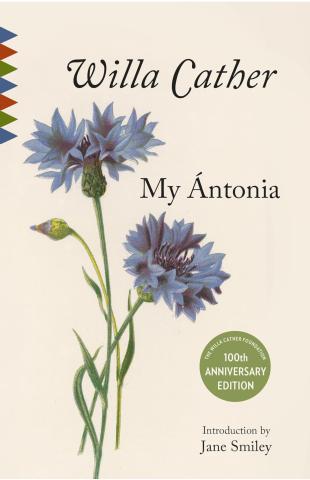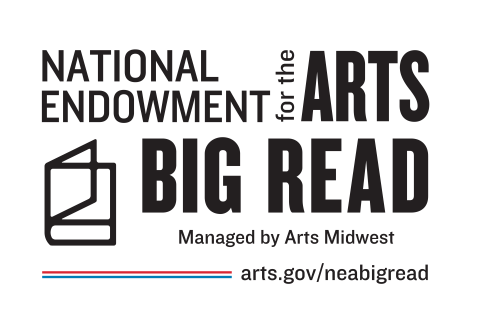

NEA Big Read: My Ántonia
Willa Cather’s My Ántonia was among the fifty titles selected by the National Endowment for the Arts for their 2024 Big Read initiative. In partnership with Arts Midwest, the NEA Big Read supports community reading programs designed around a single NEA Big Read book, with an aim to broaden our understanding of our world, our communities, and ourselves through the joy of sharing a good book.
“But finally, it all comes back to landscape, to humans changing and being changed by the difficulties and the beauties of the world they must contend with. It is also true, though, that we read older novels differently from newer ones—we read them to understand what we have lost and what we have gained, what the author knew and what she didn’t know that she knew, but that we now understand shaped the world we are living in. Because of Willa Cather’s intensity of observation, My Ántonia remains a revelation.”
— Pulitzer Prize winner Jane Smiley
About My Ántonia
When critic Randolph Bourne heralded My Ántonia in 1918 as the arrival of the “American novel,” he could not have known the many ways the novel would remain relevant to today’s American experience. For residents of the Great Plains, My Ántonia embodies the NEA’s "Where We Live" theme. The novel is set in Black Hawk, Nebraska, a town Willa Cather modeled after her childhood hometown of Red Cloud. More than that, Cather's memorable "fictional" character Ántonia Shimerda was very closely based on Cather's real-life friend, Anna Sadilek Pavelka, who immigrated to Nebraska from Bohemia (the Czech Republic today) in 1880. While My Ántonia takes place in the late 19th Century, its themes of enduring friendship and tenacity in the face of adversity are timeless. Cather’s evocative descriptions of the land and of life in rural America have drawn readers into this classic novel for more than 100 years. Just as gripping are her portrayal of obstacles such as language barriers, discrimination, and social and economic challenges.
This Big Read initiative is designed to enrich lives and bring people together for shared experiences as we read and re-read the novel. Ready to request books, a program, or an exhibit? Click below to access our booking form!
Learn more about the October 4th kick-off event
The Big Read Initiative
With the support from the National Endowment for the Arts and Arts Midwest, we are making programs and resources available to organizations and communities that wish to take part in a shared reading experience with a focus on My Ántonia and its reputation as a most “American novel.” Initiatives will take place between September 1, 2024 and June 30, 2025, and will include:
- Complimentary books for participating organizations and communities
- Book club resources
- Lectures and book discussions led by National Willa Cather Center leadership
- Place-based and online creative writing workshops
- Traveling exhibits related to the novel (please see descriptions below)
- A keynote address by Pulitzer Prize-winning author Jane Smiley at the 70th annual Willa Cather Spring Conference
- My Ántonia-themed guided tours
- A special event at the recently restored Pavelka Farmstead, a setting from the final scenes of the novel
NEA Big Read is a program of the National Endowment for the Arts in partnership with Arts Midwest. El Proyecto NEA Big Read es una iniciativa del National Endowment for the Arts (el Fondo Nacional para las Artes de Estados Unidos) en cooperacion con Arts Midwest.
Traveling Exhibits
Supplement your programming by booking a traveling exhibit for a 4-week period during the Big Read initiative. Exhibits are available for your community or organization with a booking fee of $150, plus one-way shipping.
You can read more about three exhibit options below and book them for your organization using the booking form above. A staff member will respond to your request to confirm.

David E. Scherman’s “Willa Cather Country”
David E. Scherman (1916–1997) was an American photojournalist and editor for Life magazine. He gained worldwide notoriety when he photographed fellow photographer Lee Miller in Adolph Hitler’s bathtub at the close of World War II. When Mildred Bennett began work on the Willa Cather Pioneer Memorial in Red Cloud, one of her first efforts was to bring Life magazine to Webster County to photograph the areas made famous by Willa Cather. In 1950–1951, Scherman visited on assignment for the magazine, writing that Cather “drew the American countryside with such clarity of detail and poetic accuracy that the camera, retracing her steps today, can still find and record the scenes as Willa Cather saw them and set them down.”

“For I shall be the first...” Willa Cather, “Blind” Boone, and My Ántonia
This exhibit explores the creation of two distinct but uniquely American artforms through the artistic dialogue between the Willa Cather’s novel My Ántonia and the oeuvre of John William “Blind” Boone, the African-American performer who inspired Cather’s character Blind d’Arnault. It utilizes archival imagery and artist biography to inspire patrons to grapple with larger questions, such as: How do we distinguish art from entertainment? How is American art different from classical art, and how is it continuing to change? How do we respond to problematic art and representations, such as Cather’s depiction of John William Boone? How do we imagine Boone might have received her work?

“Here at Last is an American Novel”: Willa Cather’s My Ántonia
Willa Cather’s My Ántonia was among the fifty titles selected by the National Endowment for the Arts for their 2024 Big Read initiative. In partnership with Arts Midwest, the NEA Big Read supports community reading programs designed around a single NEA Big Read book, with an aim to broaden our understanding of our world, our communities, and ourselves through the joy of sharing a good book.
My Ántonia’s worldwide appeal is demonstrated by its translation into more than thirty languages. This exhibit examines the novel’s inspirations and creation, as well as considers the ways the novel still speaks to modern readers through topics like immigration and assimilation, migration and colonialism, class divisions and labor, rural life and landscapes, and the #MeToo movement.
